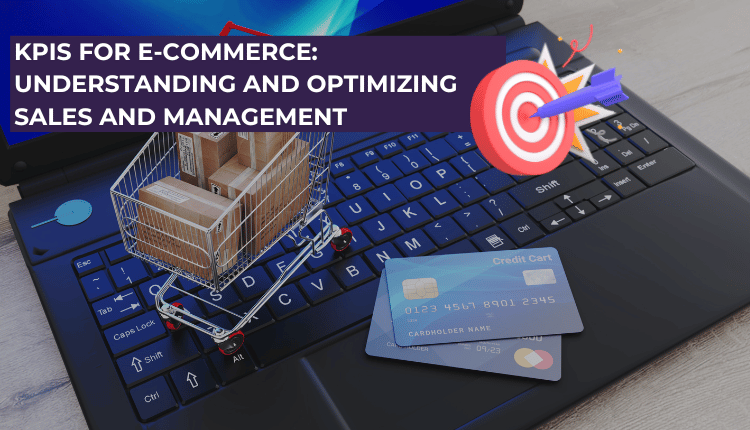KPIs are essential for any business. Having indicators that show how well your processes and activities are performing is crucial for effective management and increasing sales. Moreover, they are excellent tools for optimization.

If you work with e-commerce, you know it’s a dynamic and competitive industry. To ensure your online store succeeds, it’s vital to understand what’s working and identify areas for improvement.
This is entirely possible through the use of KPIs, as they provide data that support decision-making and help optimize processes to achieve your business goals.
In this article, you’ll discover the most important e-commerce KPIs, how to monitor them properly, and how to use this data to improve your results.
Summary
What Are KPIs?
KPI stands for Key Performance Indicator. These are numerical values that quantitatively represent how well specific business activities are being performed. Based on these figures, you can optimize your operations and drive better results.
For example, in manufacturing, some typical KPIs are:
- Number of products manufactured per hour
- Amount of a specific input used per hour/day
- Production cost per unit
These examples help illustrate why KPIs are so important. With just three metrics in a factory setting, it’s possible to gather valuable information about the business’s direction and financial health.
In e-commerce, the KPIs are different but equally powerful. Below, we’ll walk through the main ones that can help you improve your processes, operations, and — most importantly — your sales.
Types of KPIs for E-commerce
E-commerce KPIs vary depending on what you want to measure: sales performance, marketing efforts, customer service, or operational efficiency.
Here are three major categories:
- Sales KPIs – How are your sales performing?
- Marketing KPIs – Are your marketing strategies paying off?
- Customer Support KPIs – How well are you serving your customers?
Now, let’s explore each of these in detail.
Sales KPIs
Conversion Rate (CR)
The conversion rate is one of the most essential KPIs in e-commerce. It shows the percentage of website visitors who perform a desired action — typically making a purchase.
There’s no universal “good” conversion rate. For some businesses, 2% may be acceptable; for others, it may be considered low. Experts in the field suggest that an average e-commerce conversion rate falls between 2.5% and 3%, but ultimately it depends on your product, audience, and marketing funnel.
Formula:
CR = (Number of sales / Number of visitors) x 100
Where:
CR = Conversion Rate
Number of sales = Total number of purchases
Number of visitors = Total number of unique site visitors
How to improve your CR:
- Simplify your checkout process
- Improve site speed and mobile experience
- Enhance product descriptions and visuals
- Use persuasive CTAs and trust signals
Average Order Value (AOV)
Do you know how much, on average, each customer spends on your store? The AOV helps you understand this metric.
By increasing your AOV, you can grow your revenue without having to increase traffic. That means more income from your existing customer base.
Formula:
AOV = Total sales revenue / Number of orders
Where:
AOV = Average Order Value
Total sales revenue = Total revenue from all sales
Number of orders = Number of transactions completed
How to boost AOV:
- Offer product bundles or kits
- Provide volume discounts
- Implement cross-selling and upselling techniques
- Offer free shipping on orders over a certain amount
Cart Abandonment Rate (CAR)
Cart abandonment happens when a user adds items to the cart but does not complete the purchase. It’s one of the most common challenges in e-commerce.
Imagine walking into a store, filling your cart, and then walking out without buying anything — that’s cart abandonment in a nutshell.
Formula:
CAR = (Number of abandoned carts / Number of initiated carts) x 100
Where:
CAR = Cart Abandonment Rate
Number of abandoned carts = Carts where the user did not purchase
Number of initiated carts = Carts that had at least one item added
Tips to reduce CAR:
- Send cart recovery emails
- Simplify the checkout process
- Offer multiple payment options
- Display shipping costs earlier in the process
Marketing KPIs for E-commerce
Customer Acquisition Cost (CAC)
CAC indicates how much your e-commerce business spends to acquire a new customer. It’s essential to evaluate the efficiency of your marketing campaigns.
Formula:
CAC = Total marketing spend / Number of new customers acquired
Where:
CAC = Customer Acquisition Cost
Total marketing spend = Total cost of paid ads, campaigns, etc.
Number of new customers = Customers acquired within a time frame
How to lower CAC:
- Focus on high-conversion marketing channels
- Improve audience targeting
- Optimize paid advertising
- Invest in organic growth (SEO, content marketing)
Return on Investment (ROI)
ROI is a vital KPI for assessing how profitable your marketing efforts are. It tells you how much you earned in relation to how much you spent.
Formula:
ROI = [(Revenue – Cost of campaign) / Cost of campaign] x 100
Where:
ROI = Return on Investment
Revenue = Earnings from the campaign
Cost of campaign = Total amount spent on the campaign
How to improve ROI:
- A/B test ad creatives and landing pages
- Focus on high-performing campaigns
- Continuously monitor and adjust your budget allocation
Customer Support KPIs
Net Promoter Score (NPS)
NPS is a customer satisfaction metric that evaluates how likely your customers are to recommend your store to others.
The classic question is:
“On a scale from 0 to 10, how likely are you to recommend our store to a friend or colleague?”
How to calculate NPS:
- Identify Promoters (scores 9–10) and Detractors (scores 0–6)
- Subtract the percentage of Detractors from the percentage of Promoters
Formula:
NPS = % Promoters – % Detractors
Tips to increase NPS:
- Provide excellent customer service
- Resolve issues quickly and proactively
- Ask for customer feedback regularly
- Improve post-purchase experience
Customer Retention Rate (CRR)
Retention rate shows how many customers return to buy again. High retention = more loyal customers = higher long-term profitability.
Formula:
CRR = (Number of retained customers / Total number of customers) x 100
Where:
CRR = Customer Retention Rate
Number of retained customers = Customers who return to purchase
Total number of customers = All customers within the measured period
How to improve retention:
- Launch loyalty programs
- Send personalized email offers
- Offer discounts or gifts for repeat purchases
- Provide strong after-sales support
Final Thoughts
Tracking KPIs in your e-commerce business gives you data-backed insights into performance and profitability. From improving user experience and optimizing your ad spend to building loyalty and increasing revenue, KPIs guide your decisions every step of the way.
By monitoring the right KPIs — such as Conversion Rate, AOV, CAC, and NPS — you’re setting your business up for long-term success in the highly competitive e-commerce space.
Don’t just collect data. Act on it. Optimize. Grow.

